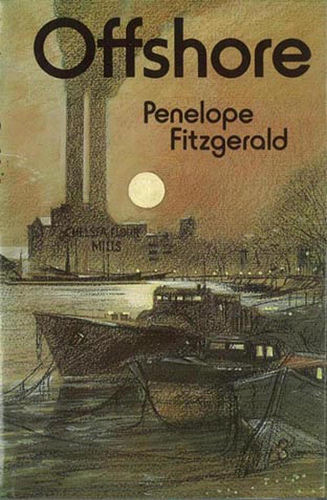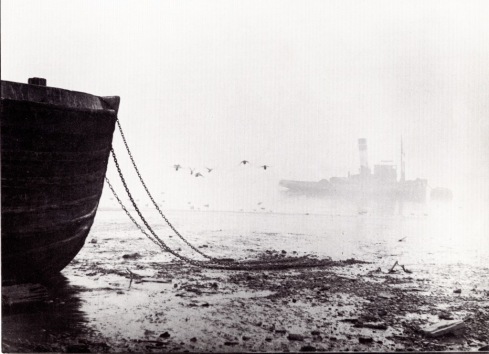When I do these posts about fiction set in Kensington and Chelsea I’m normally scrabbling around for pictures to go with the text but this post came about because there were plenty of pictures of the specific location.
A view of the houseboats at Chelsea Reach, with both Battersea and Albert Bridges in the background (even the distant chimneys of Battersea Power Station). A quinessentially Chelsea view from 1975. Chelsea reach was one of the subjects of James Hedderly’s early photography, and the location of the Greaves Boatyard, where the artist Walter Greaves painted and got some mentoring from one of his customers James McNeil Whistler. By the time John Bignell took this photograph the boating on the Reach was all residential.
The writer Penelope Fitzgerald had gone by then but the experience of living on one of the boats had left its mark and she used the enclave of houseboats as the setting for her Booker-winning novel Offshore.
This is the cover of the first hardback edition, a view which would be quite familiar to readers of this blog as it shows the main landmark looking in the other direction, Lots Road Power Station.
I’ve cropped this Bignell picture to show the whole sweep of the view looking west as the river curves towards Wandsworth. The houseboats are just visible on the right.
In real life Fitzgerald lived in the last boat along which was called Grace, nearest the offices of the Chelsea Boat Company. She lived there with her semi-estranged husband and their two daughters – there was also a son, away at boarding school. He was not surprised apparently to not find himself depicted in the book. The heroine Nenna James lives with her daughters Martha and Tilda in a fictional boat also called Grace – her husband in in Stoke Newington, a far away part of London in the early sixties.
The houseboats would eventually become fashionable and sought after locations but for the author and her fictional alter ego they were quite grim. This was a time in Fitzgeralds’s life when she had very little money.
At low tide, the boats sat on the smelly Thames mud the and residents weren’t supposed to use the toilets. At high tide they were afloat, not always a comfortable position:
At that moment Lord Jim was disturbed from stem to stern by an unmistakeable lurch….she seemed to shake herself gently, and rose. The tide had lifted her.
On every barge on the Reach a very faint ominous tap, no louder than the door of a cupboard shutting, would be followed by louder ones from every strake, timber and weatherboard, a fusillade of thunderous creaking, and even groans that seemed human.
These two pictures taken by John Rogers in 1972 depict that sense of being cut off by water. The passing vehicles on Cheyne Walk might have little sense of the little world on the water beside them.
Fitzgerald depicts a dislocated, melancholy community on the houseboats, shrouded in fog, both literal and metaphoric, which Bignell does justice to in this picture:
For the two girls Martha and Tilda the foreshore at low tide is a kind of playground.
Not wanting to compete with local children from Partisan Street (Dartrey Street) for coins, medal and lugworms they go on expeditions across the bridge to the other side of the river. On one occasion they go with a handcart to scavenge the wreck of a Thames barge. They look for tiles in the mud.
Tilda lay full length on a baulk of timber…..far beyond the point at which the mud became treacherous..she stood poised on the handlebars of a sunken bicycle.
She retrieves two tiles which turn out to be by de Morgan. They take them to an antique dealer at a shop called Le Bourgeous Gentilhomme where they get three pounds, a decent sum for two young girls in 1961.
Bignell depicts some equally dangerous play on the river.
Near the end of the novel the small family have a visitor, a teenage boy from Vienna called Heinrich. The girls take him to the King’s Road, up Partisan Street – a rough place..the refuge of crippled and deformed humanity – which Tilda no longer fears, past the Moravian burial ground where they tell him the urban myth about the Moravians being interred in a standing position, “so on Judgement Day they can rise straight upward.” (Not true by the way – every so often I have to deny it). The King’s Road is already like a gypsy encampment, another life compared to their impoverished life on the barge.
Nenna and her daughters eventually go to live with her sister in Canada. In the last chapter a storm hits the river and two of the other characters find their boat slipping its moorings and heading into the river, as good a way to end as any.
I haven’t found a picture of stormy weather on the river but here’s one of Bignell’s elegant views looking east.
Fitzgerald turned her experience of comparative poverty into a sucessful book. In 1979 she won the Booker Prize against the odds. (There’s a fascinating account of the TV coverage in Hermione Lee’s excellent 2013 biography of Fitzgerald). So for her at least her life on the houseboats at Chelsea Reach turned out well.
I once saw the actress Jacqueline Pearce (Servalan!) disembarking from one of the houseboats in the more fashionable 1980s. That would be another story.
Postscript
The photographs were by John Bignell and John Rogers, both mainstays of the blog. Thanks particularly to John Rogers for his many contributions to the Local Studies collection.















January 15th, 2015 at 12:45 am
Hi
I love your email and look forward to them every week. Photos are so evocative of the past.
I have been wondering, have you ever researched/written anything about workhouses/poorhouses in London? If so, could you please send me that entry? If not, have you ever considered it?
When I first started working on my PhD in British Victorian Lit, I researched and wrote a lot about them, but you seem to have access to resources I have never known of.
Thanks, Laura
Sent from my iPhone
>
January 16th, 2015 at 3:22 pm
Laura
Thanks, I’m glad you like the blog. As with a lot of subjects, whether or not I cover them on the blog is a matter of what pictures we have and the workhouses in Kensington and Chelsea (of which there were several) are not very well illustrated in our collection. A lot of workhouse records went not to local Boroughs but to London-wide bodies like the London Metropolitan Archives. So I probably won’t be writing about that aspect of local history in the immediate future but you never know what might come into the collection.
Dave.
January 15th, 2015 at 11:52 am
Hi David, I particularly enjoyed your latest email, so much so that I have just ordered the book, ‘Offshore’ ! My husband & I have lived on various boats over the past years, including a WW2 concrete barge in Cornwall. We loved it. Fortunately, it was not at all like the description in your text! By the way, we both hailed from West London, and your photos are very familiar as we often used to look at those barges in the ’60’s! Can’t wait to read the book now, so thank you for writing about it; and also for all your other interesting posts. Best wishes for 2015, Brenda
January 15th, 2015 at 12:01 pm
p.s. I agree with Laura, and would be interested if you have any research on the Chelsea Workhouse because I believe my grandmother might have been born there. After much searching, the only record I can find is a birth there in 1872. Would be good to see some info on the place, as Laura says, you seem to have access to many more interesting resources.
January 16th, 2015 at 6:14 pm
Dear David,
This, like all of your posts, provides a marvelous insight into streets and places I walk every day. Thank you again!
January 16th, 2015 at 11:43 pm
Hello David, just a quickie,the delicious Claire Bloom, actress lived on one of the boats on what we called Chelsea Reach.The wee foreshore that the girls would play on was used by all the local kids.It was in fact quite sandy and clean.We are talking late 1950,s early 60’s.would you believe we used to dive off the first pier of Battersea bridge swimming back to the steps near the newish Whistler statue.Whats left of the old,old Mulberry tree near by was I suspect in St.Thomas Moore’s garden.
Reg Francis
January 16th, 2015 at 11:47 pm
p.s.Chelsea Flour Mills owned by Rank Hovis Mac Dougal in those days
January 18th, 2015 at 10:32 pm
Politician David Owen was living on houseboat Amanda in 1961 according to the Electoral Register.
July 18th, 2015 at 7:07 pm
Loved this, thank you for researching these haunting photographs. I am reading Offshore at the moment. I live on a houseboat in Cornwall.
June 30th, 2020 at 3:50 pm
Lovely article. And what a great blog. I don’t know Chelsea well, having only spent one summer with some relatives on Oakley Street 25 years ago, but your blog brings it alive to me.
I am loving Offshore , all the more since stumbling across this blog and these evocative photos. I have one question: are the boats in Offshore on the Chelsea or the Battersea side? The back of my edition, and the first page of the novel, mention Battersea Reach, yet these houseboats you picture are on the Chelsea side (and the boatyard address in the book is Cheyne Walk). Can you help?
Thanks so much and again, congratulations on a brilliant blog!
July 2nd, 2020 at 5:51 pm
Steve
The houseboats in the pictures are all on the Chelsea side of the river but there are a few on the south side. I’m glad you like the blog.
Dave
September 6th, 2020 at 6:37 pm
Offshore makes it clear that the boats are off Cheyne Walk and correctly calls that part of the river “Battersea Reach”. Chelsea Reach is actually downriver from Battersea Bridge. Don’t know why Chelsea Flour Mills has been replaced by a brewery in the novel, or one of the boats is a minesweeper of a class that were all still in service at the time the novel is set.
January 23rd, 2021 at 8:54 pm
I’m a 74 year old female sailor/boater in California, a new Penelope Fitzgerald fan delighting in Offshore (The Blue Flower was my entry drug), and am excited to see your photographs of the Battersea Reach. We in San Francisco Bay have our share of derelict boats that anchor out. Offshor is a wonderful look at life with rough edges, but with boats, there is always a mysterious draw to things basic and real. Love these photographs. Thanks
April 12th, 2024 at 2:57 am
I loved the BBC dramatisation of the Foreshore.I know it must have been a difficult life for the author and her daughters but wonderful that there was a part of London and the Thames that could be experienced by people who were not wealthy.